Heartnuts in Eastern Ontario?
Gordon Wilkinson
Since 2001 I have been planting heartnut seedlings on my acreage located about 10
kilometres east of Rockland, Ontario. Developing a heartnut orchard in such a northerly
location has been an extremely challenging endeavour. Living in Vancouver since 1999
has added to the difficulties. Despite heavy losses from drought, slow growth due to
competition or allelopathic influences from grass and weeds, and setbacks and losses due
to late frosts in the spring or early frosts in the fall, I was beginning to see progress in
some of my heartnut trees over the past 4 years.
Measurements taken in mid-September of 2008 indicated that the height of my tallest
heartnut tree was 7 feet, two others were at 6-1/2 feet, and 9 others ranged in height from 4
to 5-1/2 feet - the outcome of several years of steady growth:
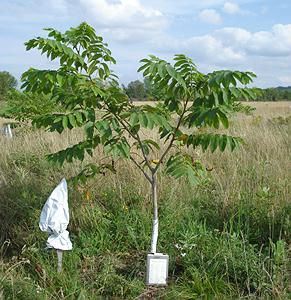
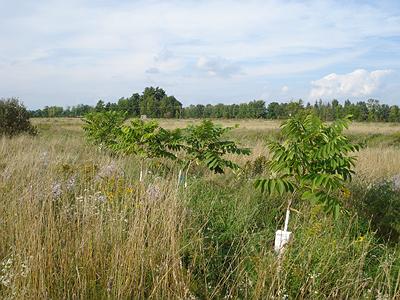
Unfortunately, my dream of a heartnut orchard was dashed when I returned to my
acreage for a visit this past July (2009). I was totally heartbroken to discover that all but one of
these larger heartnut trees were either dead or suffered severe dieback:
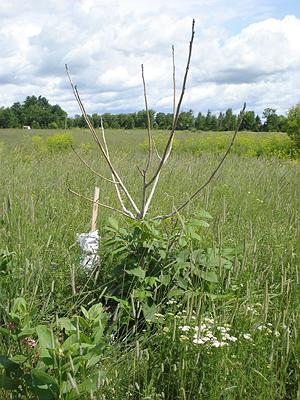
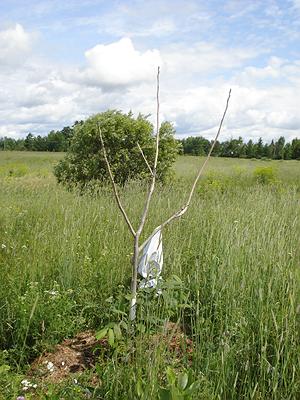
Two trees, which began to leaf out in mid-May, exhibited scorched leaves and severe
dieback in July:
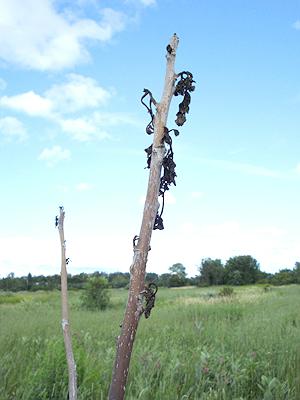
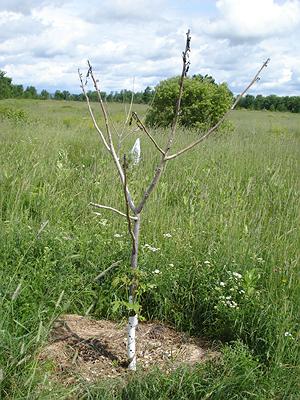
So what may have gone wrong in my orchard? Was it extreme low temperatures in the
winter? Is there a problem with my orchard site, for instance, is it situated in a frost
pocket? Or was the problem related to planting in soil with slow drainage combined with
a wetter than usual season?
Only one of my large heartnut trees failed to show any dieback (see photo below). Was this
because of its lineage - an Imshu seedling - whereas all the affected trees were CW3
seedlings? Did the Imshu lineage give it greater winter hardiness? Did it provide more
resistance to light frost or tolerance to saturated soil? Or was its performance due to its
location, which is 300 feet away from the other large heartnut seedlings and which may
have provided a slightly higher elevation or different soil conditions?
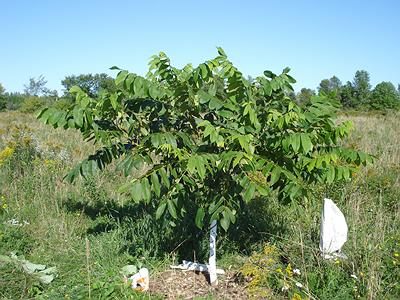
Explanation #1: Extreme Winter Temperatures
Some horticultural reference guides, for example, The American Horticultural Society's
Encyclopedia of Garden Plants, recommends Japanese walnuts (juglans ailantifolia) to
US Climatic Zone 5 or higher (equivalent to Canadian climatic zone 6 or higher). Others,
for example, The Hillier Gardener's Guide to Trees and Shrubs , recommend Japanese
walnuts to US Zone 4 or higher (equivalent to Canadian climatic zone 5 or higher).
Eastern Ontario is in Canadian climatic zone 5. This uncertainty over the hardiness of
Japanese walnut for our climatic zone suggests that some or many Heartnut trees may be
vulnerable to the extreme cold temperatures of an Eastern Ontario winter while others
may be sufficiently hardy. Given the inherent vulnerability of an unknown percentage of
heartnut to severe winter cold in Canadian zone 5, winter losses can be expected. The
lowest temperature this past winter was the coldest since the winter of 2004 (see Table
1). Did most of my large heartnut trees succumb to this low temperature extreme? Was
the steady growth in my heartnuts from the summer of 2004 to the autumn of 2008 due to
the absence of low winter temperatures potentially detrimental to their survival?
Table 1: Extreme Low Temperatures as Measured at the Ottawa International Airport
| YEAR | Extreme Low | Month
|
|---|
| 2009 | -30.3 C. | Jan.
|
| 2008 | -24.5 C. | Jan.
|
| 2007 | -26.3 C | Mar.
|
| 2006 | -21.3 C. | Both Jan. and Feb.
|
| 2005 | -28.0 C. | Jan.
|
| 2004 | -30.7 C. | Jan.
|
Explanation #2: Frost Pocket
Typically orchard trees are planted on higher terrain because cold air descends like water.
Cold air collects in low spots, which are known as frost pockets. Such spots tend to have
frost events later in spring and earlier in the fall, shortening the growing season.
Moreover, winter temperatures can be colder in such spots than in the surrounding higher
terrain. Given that elevation differences on my acreage are very slight - no more than 10
to 15 feet between the highest and lowest points -- I did not consider this to be an
important issue in the setting up of my heartnut orchard in 2001. However, I began to
reconsider my disregard for even slight elevation differences during the Thanksgiving
weekend in October of 2008. Upon my return that weekend I noticed that the leaves of
all my heartnut seedlings had been browned by frost (which I estimated to have occurred
on September 18th). One exception was the Imshu seedling tree furthest away from the
rest of the larger heartnuts. It sported a full head of healthy green leaves. The only other
exceptions were the topmost leaves of two other heartnuts. While I never would have
thought that the almost imperceptible change in elevation would have made a difference,
this outcome suggests that the slight difference in elevation may have been sufficient to
cause variations in the movement of cold air. If this is the case, the heartnut trees in the
"frost pocket" could have faced somewhat colder winter low temperatures than the Imshu
heartnut seedling tree much further away. Were these colder temperatures in the frost
pocket simply too severe for my larger heartnuts, causing mortality or severe dieback? Or
did the early frost in September make the trees less prepared for the rigours of winter?
Explanation #3: Saturated Soil
Ideally, heartnuts, like many other trees do best in well drained soils. Trees in soils with
slower drainage may suffer dieback if waterlogged conditions restrict oxygen supply to
the roots, causing them to die, which curtails water and nourishment to the rest of the
tree. Unfortunately, the heartnuts in my orchard are set in soils that are clay-based and
slow draining. These soils were considerably more saturated than usual this past spring,
presumably due to higher than normal precipitation and cooler than normal temperatures.
Soil drying around my larger heartnut trees would have been delayed further as a mulch
of woodchips laid over a thick layer of newspapers was placed around each of them in
early May. In mid-July, I was surprised to discover that the soil around the trunks of my
heartnut trees was still soggy (something I had not seen before so late in the season), so I
removed the layer of newspapers from within 8 to 12 inches of the trunks of several of
trees to improve soil drying and warming. Was the mortality or severe dieback in most of
my large heartnut trees due to their roots rotting in saturated soil? Were the roots of the
heartnut tree with the Imshu heritage more tolerant of saturated soil or was soil drainage
better at its site?
Where do I go from here?
If explanation #1 is true, the only solution is to keep on planting to stumble upon
individual heartnut trees with the hardiness of the thriving Imshu seedling tree. I have
already ordered new heartnut seedlings for planting next spring. The survival of the
Imshu seedling may be indicating that this selection has greater winter hardiness. If it
continues to grow well, it'll be interesting to see whether it will produce nuts of
acceptable quality.
If explanation #2 is true, then it is important to transplant my heartnuts out of the frost
pocket to sections of my acreage with the highest elevations. I have begun the slow
process of transplanting my heartnut trees from lower to higher elevations on my
acreage.
If explanation #3 is true, then it is important to use the various techniques available to
improve soil drainage. I have started to build mounds of top soil about 4 feet by 4 feet
and about 8 to 10 inches high to accommodate the heartnuts that I have started to
relocate.
By responding to all three possibilities, it is my hope that I can avoid the kind of disaster
that struck my heartnut trees this past season. Only the passage of time will vindicate the
soundness of the steps taken to prevent a recurrence of this season`s misfortune. A visit
to my acreage in October 2009 showed that most of the large heartnut trees that suffered
severe dieback were recovering, offering some hope for eventual success:
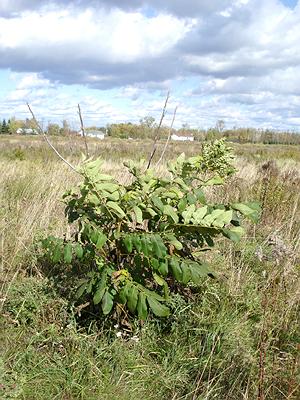
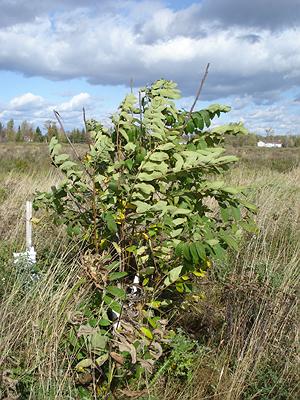
To be continued...










